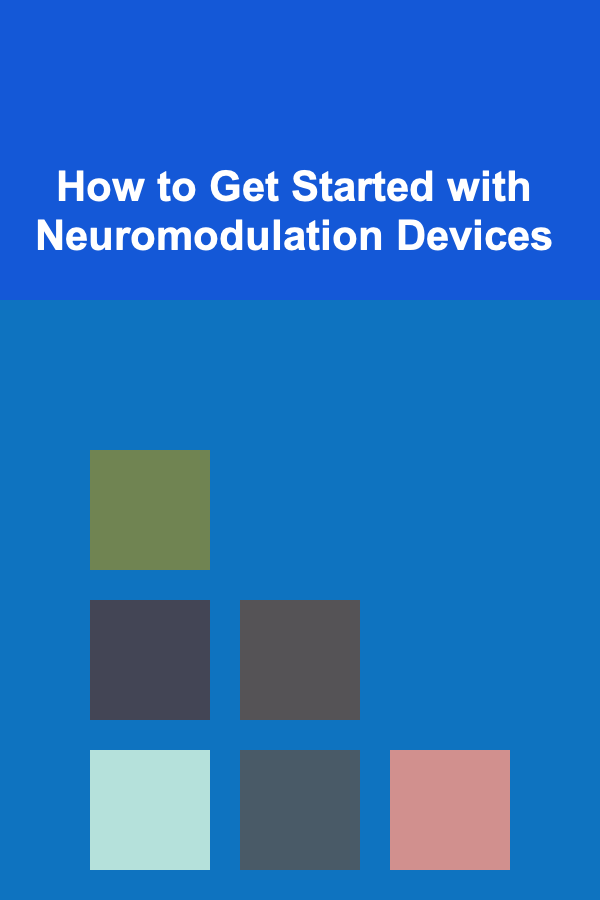
How to Get Started with Neuromodulation Devices
ebook include PDF & Audio bundle (Micro Guide)
$12.99$7.99
Limited Time Offer! Order within the next:

Neuromodulation is a rapidly evolving field of medicine that focuses on the modulation of the nervous system through targeted electrical, magnetic, or chemical interventions. The use of neuromodulation devices has grown exponentially in recent years, offering new ways to treat various neurological conditions, ranging from chronic pain to psychiatric disorders like depression and anxiety. These devices can alter the activity of nerves in specific parts of the body, providing relief or improving symptoms without the need for invasive surgery.
In this article, we will delve into how to get started with neuromodulation devices, including the principles behind their function, the different types of devices, how they are used in clinical settings, and what you need to know to begin incorporating them into your therapeutic practices or personal health routine.
Understanding the Basics of Neuromodulation
What is Neuromodulation?
Neuromodulation refers to the process of changing or modulating the activity of the nervous system. The goal is often to restore or enhance normal nerve function, which can be disrupted due to injury, disease, or other medical conditions. Neuromodulation can be achieved through electrical, magnetic, or chemical means, depending on the specific needs of the patient or condition being treated.
How Neuromodulation Devices Work
Neuromodulation devices work by delivering targeted electrical impulses or magnetic fields to specific areas of the nervous system. These devices typically work through a combination of technologies, such as:
- Electrical Stimulation: Delivering low electrical currents to the nervous system to alter neural activity.
- Magnetic Stimulation: Using powerful magnetic fields to influence the activity of neurons in specific brain regions.
- Chemical Modulation: Using drugs or biologics to influence nerve activity in the body or brain.
The devices themselves can range from relatively simple wearable units to complex surgically implanted systems, depending on the condition being treated.
Types of Neuromodulation Devices
2.1. Transcranial Magnetic Stimulation (TMS)
Transcranial Magnetic Stimulation (TMS) is a non-invasive neuromodulation technique that uses magnetic fields to stimulate or suppress activity in specific areas of the brain. It is commonly used in the treatment of conditions like depression, anxiety, and chronic pain. The TMS device consists of a magnetic coil placed near the scalp, which generates a magnetic field that penetrates the skull and alters the electrical activity of neurons.
How to Use TMS:
- Setup: A trained professional will place the TMS coil on the patient's scalp.
- Treatment Sessions: Sessions typically last between 20 to 40 minutes, and the patient may need multiple sessions over a period of weeks.
- Safety Considerations: It is generally considered safe, but patients with metal implants or certain medical conditions may not be eligible.
2.2. Transcranial Direct Current Stimulation (tDCS)
Transcranial Direct Current Stimulation (tDCS) is a technique that uses low electrical currents to modulate the activity of the brain. It works by applying electrodes to the scalp, delivering a mild electrical current that alters neuronal excitability. tDCS is often used for cognitive enhancement, mood disorders, and rehabilitation.
How to Use tDCS:
- Electrode Placement: Electrodes are placed on the scalp, and a weak current is passed through the brain for a set period.
- Duration: Each session typically lasts between 15 and 30 minutes.
- Effectiveness: tDCS has been shown to improve learning, memory, and cognitive function in some individuals.
2.3. Spinal Cord Stimulation (SCS)
Spinal Cord Stimulation (SCS) involves implanting a small device near the spinal cord that sends electrical pulses to the nerves. This technique is primarily used for the management of chronic pain, particularly in conditions like failed back surgery syndrome, complex regional pain syndrome, and neuropathic pain.
How to Use SCS:
- Implantation: The device is surgically implanted near the spinal cord, with leads placed in the epidural space.
- Pain Management: The device sends electrical signals to the spinal cord to interrupt pain signals traveling to the brain.
- Adjustment: Patients can control the intensity of the stimulation using an external remote control.
2.4. Vagus Nerve Stimulation (VNS)
Vagus Nerve Stimulation (VNS) involves implanting a small device under the skin in the chest, with a lead that is connected to the vagus nerve. The device sends electrical impulses to the vagus nerve, which then travels to the brain. VNS is often used in the treatment of epilepsy and depression, particularly when other treatments have failed.
How to Use VNS:
- Implantation: A device is implanted in the chest, with a lead wrapped around the vagus nerve in the neck.
- Continuous Stimulation: The device delivers electrical impulses periodically, and the patient may also have the option to adjust stimulation intensity through an external magnet.
- Effectiveness: VNS is considered effective for patients who have not responded well to other treatments, particularly in epilepsy.
2.5. Deep Brain Stimulation (DBS)
Deep Brain Stimulation (DBS) is a highly sophisticated form of neuromodulation that involves implanting electrodes in specific areas of the brain to regulate abnormal brain activity. DBS is most commonly used in the treatment of Parkinson's disease, essential tremor, and dystonia, though its use is expanding to other neurological conditions.
How to Use DBS:
- Implantation: Surgeons implant electrodes in targeted areas of the brain, typically the subthalamic nucleus or globus pallidus.
- Stimulation: A pulse generator is implanted under the skin in the chest, sending electrical impulses to the brain to correct irregular neural activity.
- Adjustment: The stimulation parameters can be adjusted non-invasively by a physician to achieve the optimal therapeutic effect.
How to Get Started with Neuromodulation Devices
3.1. Determine the Need for Neuromodulation
The first step in getting started with neuromodulation is to determine whether it is an appropriate treatment option for you or your patients. Neuromodulation devices are typically used when other conventional treatments, such as medications or physical therapy, have failed to provide adequate relief. Common conditions that can benefit from neuromodulation include:
- Chronic Pain: Including back pain, neuropathic pain, and fibromyalgia.
- Depression: Particularly treatment-resistant depression.
- Parkinson's Disease: To manage motor symptoms like tremors.
- Epilepsy: For patients with seizures that are not controlled by medication.
- Cognitive Enhancement: Improving memory and focus in healthy individuals or those with cognitive impairments.
3.2. Consult a Specialist
Neuromodulation is a specialized field that requires careful consideration of a patient's medical history, condition, and specific needs. Before starting with any neuromodulation device, it is crucial to consult with a healthcare provider, such as a neurologist, psychiatrist, or pain management specialist. They will evaluate your condition and determine whether neuromodulation is an appropriate option, as well as which device would be most beneficial.
3.3. Choosing the Right Device
Once you have consulted with a specialist, the next step is to choose the appropriate neuromodulation device for your needs. The choice of device will depend on factors such as:
- The specific condition being treated.
- The severity of symptoms.
- The treatment goals (e.g., pain relief, mood stabilization, cognitive improvement).
- Personal preferences, such as the desire for non-invasive treatments versus surgical options.
For example, if you're seeking treatment for depression and prefer a non-invasive approach, Transcranial Magnetic Stimulation (TMS) may be appropriate. However, if you're dealing with chronic pain that hasn't responded to other treatments, a Spinal Cord Stimulation (SCS) device may be a better option.
3.4. Undergo Initial Testing or Trials
In many cases, healthcare providers will conduct a trial period to assess the effectiveness of a neuromodulation device before proceeding with permanent implantation. For example, in the case of spinal cord stimulation, a temporary device may be implanted to determine whether it successfully alleviates pain before committing to a permanent implant.
These trial runs can help you and your healthcare provider make an informed decision about whether the device is providing the desired therapeutic effects.
3.5. Understand the Risks and Benefits
Neuromodulation devices, while generally considered safe, are not without risks. These risks vary depending on the type of device and the specific procedure involved. For example, implantable devices may carry risks of infection, bleeding, or device malfunction, while non-invasive methods like TMS carry a lower risk but may cause mild discomfort during treatment.
It is important to thoroughly discuss the potential risks and benefits with your healthcare provider to ensure that you are making an informed decision.
3.6. Commit to Long-Term Care
For those opting for implantable neuromodulation devices, long-term care is often necessary. This can include periodic adjustments to the device, monitoring for side effects, and occasional device replacements or maintenance. Patients may need to visit their healthcare provider regularly to ensure the device is working effectively and to make any necessary adjustments.
Conclusion
Neuromodulation devices are transforming the landscape of modern medicine, offering non-invasive and minimally invasive treatment options for a variety of neurological and psychological conditions. By understanding the types of devices available, the conditions they treat, and how to get started with them, you can make informed decisions about whether neuromodulation is the right choice for you.
Whether you are a patient looking to explore new treatments or a healthcare provider seeking to integrate these technologies into your practice, neuromodulation offers a promising avenue for improving the quality of life for many individuals dealing with challenging conditions.

How to Create a Checklist for Medical Preparedness in an Emergency
Read More
How to Organize Your Entryway for Maximum Space Efficiency
Read More
How to Soundproof Your Home During a Renovation
Read More
How to Use Shelf Risers for Better Visibility
Read More
How to Consider Weight Loss Medications Safely
Read More
How to Use a Knitting Planner to Track Your Progress and Stay Motivated
Read MoreOther Products

How to Create a Checklist for Medical Preparedness in an Emergency
Read More
How to Organize Your Entryway for Maximum Space Efficiency
Read More
How to Soundproof Your Home During a Renovation
Read More
How to Use Shelf Risers for Better Visibility
Read More
How to Consider Weight Loss Medications Safely
Read More